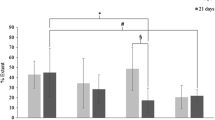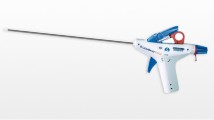Abstract
Background
Adhesion formation remains an important issue in hernia surgery. Liquid agents were developed for easy and versatile application, especially in laparoscopy. The aim of this study was to compare the antiadhesive effect of fibrin sealant (FS, Artiss®), Icodextrin (ID, Adept®) and Polyethylene glycol (PEG, CoSeal®) alone and in combination and to evaluate the resulting effect on tissue integration of the mesh.
Methods
A total of 56 Sprague–Dawley rats were operated in open IPOM technique. A middleweight polypropylene mesh of 2 × 2 cm size was implanted and covered with 1: FS, 2: ID, 3: PEG, 4: FS + ID, 5: FS + PEG, 6: PEG + ID, 7: control group, uncovered mesh (n = 8 per treatment/control). Observation period was 30 days. Macroscopic and histological evaluation was performed.
Results
Severe adhesions were found in group 2 (ID), group 6 (PEG + ID) and the controls. Best results were achieved with FS alone or FS + ID. Mesh integration in the treatment groups was reduced in comparison with the control group. This is a new finding possibly relevant for the outcome of intraperitoneal mesh repair. Group 6 (PEG + ID) showed an impairment of tissue integration with <50 % of the mesh surface in seven samples.
Conclusion
FS alone and in combination with ID yielded excellent adhesion prevention. ID alone did not show significant adhesion prevention after 30 days. Tissue integration of FS-covered meshes was superior to ID or PEG alone or combined. PEG did show adhesion prevention comparable to FS but evoked impaired tissue integration. So Artiss® is among the most potent antiadhesive agents in IPOM repair.




Similar content being viewed by others
References
Jenkins ED, Yom V, Melman L, Brunt LM, Eagon JC, Frisella MM et al (2010) Prospective evaluation of adhesion characteristics to intraperitoneal mesh and adhesiolysis-related complications during laparoscopic re-exploration after prior ventral hernia repair. Surg Endosc 24(12):3002–3007
ten Broek RPG, Issa Y, van Santbrink EJP, Bouvy ND, Kruitwagen RFPM, Jeekel J et al (2013) Burden of adhesions in abdominal and pelvic surgery: systematic review and met-analysis. BMJ 347:f5588
Ellis H (1982) The causes and prevention of intestinal adhesions. Br J Surg 69(5):241–243
Wassenaar EB, Schoenmaeckers EJP, Raymakers JTFJ, Rakic S (2010) Subsequent abdominal surgery after laparoscopic ventral and incisional hernia repair with an expanded polytetrafluoroethylene mesh: a single institution experience with 72 reoperations. Hernia 14(2):137–142
Zhang Z, Zhou X, Ru J, Jiang S, Du H, Ni Y et al (2006) Characteristics of genesis and development of peritoneal adhesion by different causes: experiment with rats. Zhonghua Yi Xue Za Zhi 86(46):3285–3289
Molinas CR, Mynbaev O, Pauwels A, Novak P, Koninckx PR (2001) Peritoneal mesothelial hypoxia during pneumoperitoneum is a cofactor in adhesion formation in a laparoscopic mouse model. Fertil Steril 76(3):560–567
Ott DE (2008) Laparoscopy and adhesion formation, adhesions and laparoscopy. Semin Reprod Med 26(4):322–330
diZerega GS, Campeau JD (2001) Peritoneal repair and post-surgical adhesion formation. Hum Reprod Update 7(6):547–555
Dasiran F, Eryilmaz R, Isik A, Okan I, Somay A, Sahin M (2015) The effect of polyethylene glycol adhesion barrier (Spray Gel) on preventing peritoneal adhesions. Bratisl lekárske List 116(6):379–382
Martins e Quinino R, Araújo-Filho I, Lima FP, Barbosa ALC, de Maia TC, Goldenberg A (2013) Adhesion prevention in reabsorbable polyethylene glycol hydrogel (Coseal®) coated polypropylene mesh in rabbits. Acta cirúrgica Bras/Soc Bras para Desenvolv Pesqui em Cir 28(12):807–814
Petter-Puchner AH, Walder N, Redl H, Schwab R, Öhlinger W, Gruber-Blum S et al (2008) Fibrin sealant (Tissucol) enhances tissue integration of condensed polytetrafluoroethylene meshes and reduces early adhesion formation in experimental intraabdominal peritoneal onlay mesh repair. J Surg Res 150(2):190–195
Champault G, Torcivia A, Paolino L, Chaddad W, Lacaine F, Barrat C (2011) A self-adhering mesh for inguinal hernia repair: preliminary results of a prospective, multicenter study. Hernia 15(6):635–641
Gruber-Blum S, Riepl N, Brand J, Keibl C, Redl H, Fortelny RH et al (2014) A comparison of Progrip(®) and Adhesix (®) self-adhering hernia meshes in an onlay model in the rat. Hernia 18(5):761–769
Jenkins ED, Lerdsirisopon S, Costello KP, Melman L, Greco SC, Frisella MM et al (2011) Laparoscopic fixation of biologic mesh at the hiatus with fibrin or polyethylene glycol sealant in a porcine model. Surg Endosc 25(10):3405–3413
Fortelny RH, Petter-Puchner AH, Redl H, May C, Pospischil W, Glaser K (2014) Assessment of pain and quality of life in Lichtenstein hernia repair using a new monofilament PTFE mesh: comparison of suture vs. fibrin-sealant mesh fixation. Front Surg 1:45
Gruber-Blum S, Petter-Puchner AH, Brand J, Fortelny RH, Walder N, Oehlinger W et al (2011) Comparison of three separate antiadhesive barriers for intraperitoneal onlay mesh hernia repair in an experimental model. Br J Surg 98(3):442–449
Vandendael A, Struwig D, Nel JT, Kruger TF, Lombard CJ (1996) Efficacy of fibrin sealant in prevention of adhesion formation on ovar surgical wounds in rabbit model. Gyn End 5:169–172
Petter-Puchner AH, Fortelny RH, Mittermayr R, Walder N, Ohlinger W, Redl H (2006) Adverse effects of porcine small intestine submucosa implants in experimental ventral hernia repair. Surg Endosc 20(6):942–946
Mutter D, Jamali FR, Moody DL, Rodeheaver GT, Thérin M, Marescaux J (2000) The concept of protected mesh to minimize adhesion formation in intraperitoneat abdominal wall reinforcement. Preclinical evaluation of a new composite mesh. Hernia 4(S1):S3–S9
Hanna EM, Byrd JF, Moskowitz M, Mann JWF, Stockamp KT, Patel GN et al (2014) Outcomes of a prospective multi-center trial of a second-generation composite mesh for open ventral hernia repair. Hernia 18(1):81–89
Schreinemacher MHF, Emans PJ, Gijbels MJJ, Greve J-WM, Beets GL, Bouvy ND (2009) Degradation of mesh coatings and intraperitoneal adhesion formation in an experimental model. Br J Surg 96(3):305–313
Brown CB, Luciano AA, Martin D, Peers E, Scrimgeour A, DiZerega GS et al (2007) Adept (icodextrin 4% solution) reduces adhesions after laparoscopic surgery for adhesiolysis: a double-blind, randomized, controlled study. Fertil Steril 88(5):1413–1426
diZerega GS, Verco SJS, Young P, Kettel M, Kobak W, Martin D et al (2002) A randomized, controlled pilot study of the safety and efficacy of 4% icodextrin solution in the reduction of adhesions following laparoscopic gynaecological surgery. Hum Reprod 17(4):1031–1038
van’t Riet M, de Vos van Steenwijk PJ, Bonthuis F, Marquet RL, Steyerberg EW, Jeekel J et al (2003) Prevention of adhesion to prosthetic mesh: comparison of different barriers using an incisional hernia model. Ann Surg 237(1):123–128
Acknowledgments
The authors wish to thank K. Brenner for animal care, K. Kropik for technical support, W. Öhlinger for the histological analysis and I. Jung for statistical analysis. SGB was awarded the runner-up Andrew Kingsnorth Prize for presentation of the given data at the 36th International Congress of the European Hernia Society 2014 in Edinburgh, UK.
Author information
Authors and Affiliations
Corresponding author
Ethics declarations
Disclosures
S. Gruber-Blum, J. Brand, C. Keibl and M. Lechner have no conflicts of interest or financial ties to disclose. H. Redl and R. H. Fortelny worked as consultant for Baxter Biosciences during the conduction of the study. A. H. Petter-Puchner has received travel grants from Baxter.
Rights and permissions
About this article
Cite this article
Gruber-Blum, S., Fortelny, R.H., Keibl, C. et al. Liquid antiadhesive agents for intraperitoneal hernia repair procedures: Artiss® compared to CoSeal® and Adept® in an IPOM rat model. Surg Endosc 31, 4973–4980 (2017). https://doi.org/10.1007/s00464-016-5277-z
Received:
Accepted:
Published:
Issue Date:
DOI: https://doi.org/10.1007/s00464-016-5277-z




